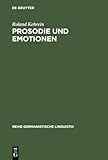Prosodie und Emotionen / Roland Kehrein.
Material type: TextSeries: Reihe Germanistische Linguistik ; 231Publisher: Tübingen : Max Niemeyer Verlag, [2013]Copyright date: ©2002Edition: Reprint 2012Description: 1 online resource (349 p.)Content type:
TextSeries: Reihe Germanistische Linguistik ; 231Publisher: Tübingen : Max Niemeyer Verlag, [2013]Copyright date: ©2002Edition: Reprint 2012Description: 1 online resource (349 p.)Content type: - 9783484312319
- 9783110940763
- online - DeGruyter
- Issued also in print.
| Item type | Current library | Call number | URL | Status | Notes | Barcode | |
|---|---|---|---|---|---|---|---|
 eBook
eBook
|
Biblioteca "Angelicum" Pont. Univ. S.Tommaso d'Aquino Nuvola online | online - DeGruyter (Browse shelf(Opens below)) | Online access | Not for loan (Accesso limitato) | Accesso per gli utenti autorizzati / Access for authorized users | (dgr)9783110940763 |
Frontmatter -- Inhalt -- Übersicht über die verwendeten Symbole nach den Konventionen des Gesprächsanalytischen Transkriptionssystems (GAT) -- Vorwort -- 1. Einleitung -- 2. Prosodie -- 3. Ein Modell zur Beschreibung von Prosodie im Deutschen -- 4. Emotionen -- 5. Eigene empirische Untersuchungen -- 6. Prosodische Einheiten des Deutschen -- 7. Wahrnehmung von Emotionen im Lego-Korpus -- 8. Emotionen im Lego-Korpus und das Komponenten-Prozess- Modell -- 9. Ergebnisse und Ausblick: Sprache, Prosodie und Emotionen -- Literatur -- Terminologisches Register
restricted access online access with authorization star
http://purl.org/coar/access_right/c_16ec
Gegenstand der vorliegenden Arbeit ist die empirische Untersuchung des prosodischen Ausdrucks authentischer Emotionen. Durch die gezielte Gestaltung der Aufnahmesituation konnte ein Korpus an Sprachdaten zusammengestellt werden, das folgende Eigenschaften aufweist: zwangloses Sprechverhalten und eine Vielzahl alltäglicher Emotionen bei gleichzeitig sehr hoher Aufnahmequalität. Die konversationsanalytische und akustische Beschreibung des umfangreichen Sprachmaterials führt zu zwei zentralen Ergebnissen: Auf der einen Seite konnte ein einfaches Prosodiemodell für das Deutsche entworfen werden, das neben zwei globalen prosodischen Einheiten (Intonationsmuster) mit redesyntaktischer Funktion fünf lokale prosodische Einheiten mit informationsstrukturierenden und kommunikationsorganisierenden Funktionen enthält. Auf der anderen Seite wird für den prosodischen Emotionsausdruck erstmals anhand 'echter' kommunikativer Interaktion empirisch belegt, daß prosodische Einheiten und akustische Parameter mit Bedeutungsanteilen in Zusammenhang stehen, die in der Emotionspsychologie als semantische Dimensionen von Emotionen anerkannt sind. Prosodisch ausgedrückt werden Nichterwartetheit, Stärke/Schwäche (Dominanzdimension), Erregung/Ruhe (Aktivierungsdimension) und eine positive Einstellung/Befindlichkeit (Valenzdimension). Der Sprachwissenschaft wird somit ein Instrumentarium an die Hand gegeben, das für die Analyse der Prosodie sowie sprachlicher Interaktion allgemein geeignet ist.
This study is the first of its kind to offer a comprehensive analysis of authentic everyday emotions as opposed to the simulated or stylized variety. Extensive material distinctive for its combination of unforced language behaviour, extremely good recording quality, and a high frequency of recurrent interaction sequences makes it possible to propose an empirically well-founded and at the same time surprisingly simple model of German prosody. On this basis, the study identifies four fundamental emotional dimensions directly connected with prosodic units and acoustic parameters.
Issued also in print.
Mode of access: Internet via World Wide Web.
In German.
Description based on online resource; title from PDF title page (publisher's Web site, viewed 28. Feb 2023)


